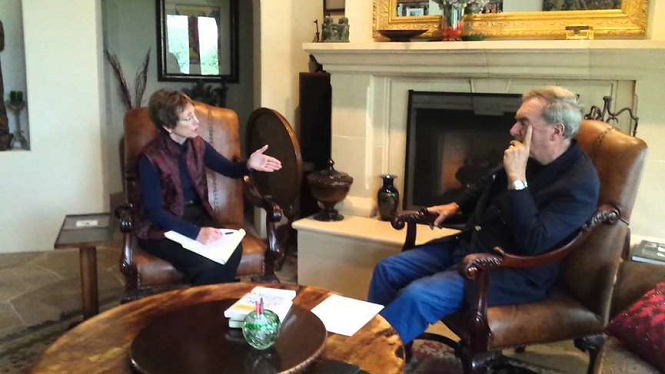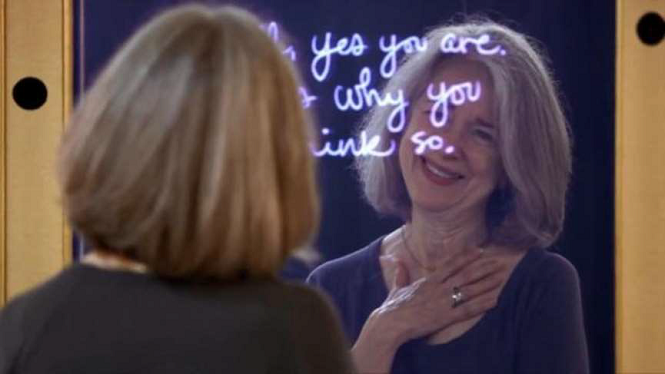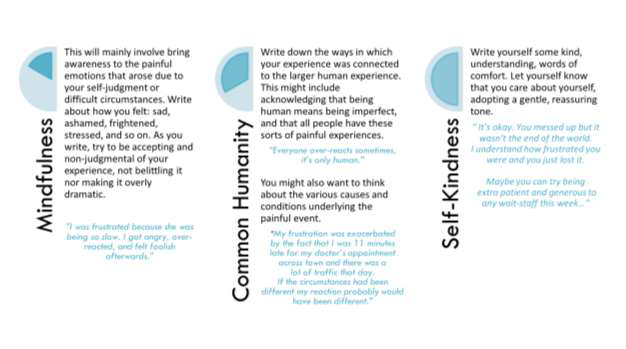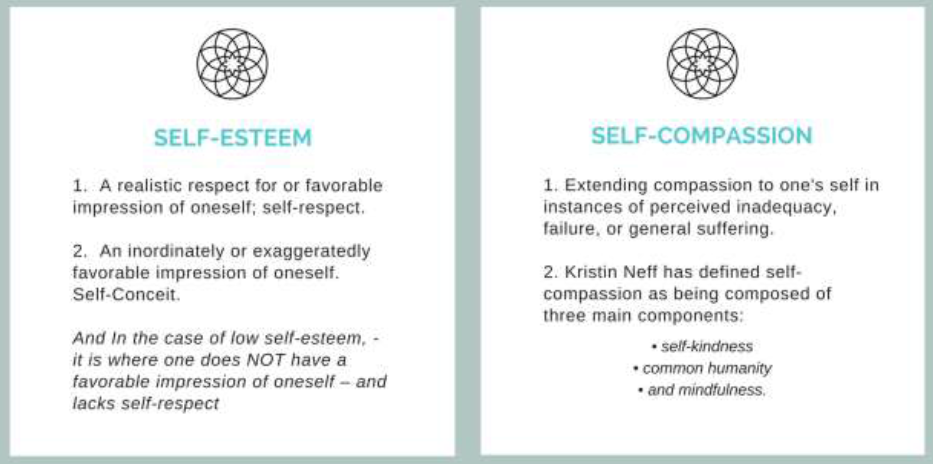
A Coaching Power Tool Created by Holly Hansen
(Empowerment and Transformation Coach, UNITED STATES)
 At a glance – most people might think that self-compassion is similar to self-esteem, but they are different, and it is worthwhile comparing the differences.
At a glance – most people might think that self-compassion is similar to self-esteem, but they are different, and it is worthwhile comparing the differences.
This Power tool of Pursuing Positive Self-Esteem vs Practicing Self- Compassion is all about helping you as a coach understanding the difference between pursuing positive self-esteem and practicing self-compassion, as well as the impact, pros and cons, each of these areas can have on our own lives, as well as our client lives.
Quick Power Tool Summary
Based on my work with my clients and my own personal revelations and transformation – I came to a very powerful conclusion.
If one chooses to focus on building positive self-esteem, there are many negative risks, including narcissism that can in essence prevent you from sustained healthy self-esteem, confidence and even happiness.
Whereas when one focuses on a consistent practice of self-compassion, which has no known negative risks, the benefits research uncovered, include healthier self-esteem, self-confidence and a happier more balanced life filled with self-acceptance. So in essence if a client truly wants more self-esteem and self-confidence – the more effective and empowering route is most likely building a practice of self-compassion.
In this paper, we will explore this idea in more depth by reviewing:
Let’s begin with the definitions of both
According to Wikipedia Page on Self Compassion:
Self-compassion has different effects than self-esteem, a subjective emotional evaluation of the self.
Although psychologists extolled the benefits of self-esteem for many years, recent research has exposed costs associated with the pursuit of high self-esteem, including narcissism, distorted self-perceptions, contingent and/or unstable self-worth, as well as anger and violence toward those who threaten the ego.
It appears that self-compassion offers the same mental health benefits as self-esteem, but with fewer of its drawbacks such as narcissism, ego-defensive anger, inaccurate self-perceptions, self-worth contingency, or social comparison.
Now that we have some basic insights into Self-Esteem vs Self-Compassion, Let’s delve in deeper and look at the differences between these two ideas. HOW
Global views contributed to the current popularization of self-esteem over self-compassion
It is worthwhile noting the differences between the unique definitions of Ideal Mental Health of West vs East – and how this greatly contributed toward the current popularity of focusing on building positive self-esteem, we are seeing in the West today.
Ideals of mental health in the classic Eastern System: Emphasize harmony, social integration, balanced functioning, protection, and caring
Ideals of mental health in the classic Western System: Emphasize self-sufficiency, personal autonomy, efficiency & self-esteem.
While the concepts of mindfulness and self-compassion has been around for over 2500 years, and rooted in Eastern traditional Buddhist philosophy and Buddhist meditation, Self-Esteem only recently became a popular concept in psychology beginning in the 1960s – and mostly in Western Cultures.
Since the 1960s – the predominantly western idea of building positive self-esteem has caught on like wildfire – with plenty of books, movies, educational programs and events all focused on this idea that we need to improve our self-esteem and we will then be happier people.
Interesting Fact:
When you do a search on US Amazon for Books offered for Sale:
83,924 Books on Self-Esteem
Only 1,510 Books Self Compassion
And while a popular idea, pursuing positive self-esteem, in fact it would seem when you compare the pros and cons of focusing on positive self-esteem vs self-compassion it becomes clear that pursuing and practicing self-compassion is in fact a more beneficial choice.
Comparing the Pros and Cons of Pursuing Positive Self Esteem vs. Self Compassion
On the surface self-esteem and self-compassion seem to aim for similar goals. But the results of working to pursuing self-esteem vs practicing self-compassion can have different results.
A few of the key differences between these two ideals
1. There are far greater downsides and risks to pursuing positive self-esteem over practicing self-compassion (see both graphics below for pros and cons)
a. When someone is focused on building positive self-esteem, is it can result in narcissism and false, even fragile confidence – which effectively hinders compassion towards others. In fact, there is quite a large list of possible negative results
b. In contrast, if someone works towards adding more self-compassion to their lives – possible result can include a healthy sense of self, a strong natural confidence, can also increase compassion and empathy and therefore a sense of connection with others. As for the negatives associated with Self-compassion, there have yet to be discovered any.
2. Whereas self-compassion is based on realistic appraisals of oneself, self-esteem is sometimes based on false assumptions.
Let’s see what happens when one focuses on Building positive self-esteem vs positive self-compassion
As you will see below, that while there are many benefits for achieving positive selfesteem, that path has a lot of risks when pursuing. Whereas focusing instead on practicing self-compassion, you can receive all the positive benefits we all hope for when pursuing self-esteem – without the negatives.
Quick overview of pros and cons
High self-compassion is associated with greater life satisfaction, and less self-criticism, anxiety, and depression. It also promotes a more stable sense of self, so that hardships in life are more easily recovered from.
Finally, self-compassion has been shown to be equal to self-esteem in promoting happiness and well-being, without being associated with narcissism and other negative affects.
Benefits of pursuing positive self esteem and self compassion
So while it would seem that there are plenty of worthwhile and desirable reasons to pursue building self-esteem or self-compassion. If you simply saw the green benefit list, it wouldn’t matter whether you chose to focus on pursuing positive self-esteem or practicing self-compassion, but this isn’t telling you the whole balanced view.
When you look at the below red box graphic – it outlines some of the potential negatives one can run into when pursuing positive self-esteem.
As far as potential negatives for pursuing positive self-esteem – in all my research, I could not find any. So I reached out to Self-Compassion Expert and Researcher Kristin Neff and when I asked her about if there were any cons to pursuing self-compassion here is what she responded:
I haven’t discovered any cons to self-compassion as long as it’s truly self-compassion, and not something else parading as self-compassion (like self-pity or self-indulgence). There is only one published research study that found any downsides to self-compassion, and only for men (not women) who were low in contentiousness and high in selfcompassion – which makes me wonder if it wasn’t true self-compassion. Also, usually people high in self-compassion are also high in contentiousness, making the population a bit odd.
NEXT: Coaching Application for this Power Tool:
Now that we have a solid understanding of the breadth, scope pros and cons of pursuing positive self-esteem vs practicing self-compassion, It’s time to move onto how we can use this information along with our Coaching Toolbox to help our clients when they are in need in this area

Coaching application for this power tool:
So how can you use this power tool as a coach with your clientele?
1. First, while you are coaching, listen to their comments to recognize when this might be a good power tool for your client
2. And then based on your familiarity of Kristen Neff’s 3 processes behind Self- Compassion and insights about your client’s needs, personality and learning style, you can decide which Coaching Tool(s) might best help your client achieve the pursuit of practicing self-compassion
Recognizing when this might be a good power tool for a client
If you have a client that expresses any of the following:
And they might mention desires to:
Did this sound like your client?
If so, you may want to share with them the definitions and differences of focusing on pursuing positive self-esteem vs practicing self-compassion to see if focusing on self compassion would be a better fit for them.
It might also be a good time to share with them Kristin Neff’s Three Processes that make up Self-Compassion, to help them to start thinking about how they might integrate self compassion into their lives.
As their Coach you can use this knowledge about Self-Compassion and your familiarity with your client to help them decide the best coaching tool fit (visualization, journaling, meditation or some other tool ) so they can build a lasting and empowering practice of Self-Compassion.
Three Process that make up self compassion
( SOURCE: Professor Kristin Neff )
1. Self-Kindness
Extending kindness and understanding to oneself instead of harsh selfjudgment and criticism
2. Sharing a common sense of humanity with others
Seeing one’s experiences as part of the larger human experience rather than seeing them as separating and isolating
3. Being mindful when considering personal weakness or hardships
Holding one’s painful thoughts and feelings in balanced awareness rather than over-identifying with them
 Now that we are familiar Neff’s helpful definition of Self-Compassion, let’s take a look at four coaching tools that might be a good fit to help your clients add Self-Compassion to their daily lives.
Now that we are familiar Neff’s helpful definition of Self-Compassion, let’s take a look at four coaching tools that might be a good fit to help your clients add Self-Compassion to their daily lives.
Self compassion power tool: Coaching tools, structures and exercises
In the following pages we will review these coaching tools to help you, help your clients with the Self Compassion Power Tool
- Progressive and Exploratory Questions
- Visualizations as a Tool for Helping Build Self Compassion Skills
- Self-Compassion Journaling
- Self-Compassion focused Meditation

Progressive and Exploratory Questions
 These progressive coaching questions will help you, help your client move forward through the different stages of their Journey to help them pursue and integrate Self-Compassion into their lives.
These progressive coaching questions will help you, help your client move forward through the different stages of their Journey to help them pursue and integrate Self-Compassion into their lives.
Journey Stage 1 : The Problem, The Revelation This is the beginning of the journey. And it begins by looking at the past and present to fully understand the current challenges of the client. As a Coach, it should be your intent to identify and uncover if they might be struggling with lack of self-compassion.
Journey Stage 2 : The Possibilities Now that the challenges, obstacles and problems have been uncovered – now it’s time to understand what they have tried so far, what is motivating their desire for change.
Journey Stage 3 : The Plan Now that you know their current foundation of concerns, feelings and motivations; you can shift the conversation to focus on aiding them in their exploration of making a plan for how they want/need to integrate self-compassion into their lives.
Final Journey Stage : The Integration This is the last step in the clients’ journey for these Coaching Questions. The Client has now made a journey to fully uncover the obstacles to self-compassion, revealed their motivations for change, created a plan for how to bring more self-compassion in their life. So now they have an opportunity to plan to ensure they can fully integrate these changes into their life by making a plan for what to do if they find themselves falling back to old non self-compassionate patterns and habits – and also acknowledge the impact of not integrating self-compassion in their lives.
Revelation Questions
Helping clients uncover and become aware of their present state
Exploring Possibilities Questions
Helping clients explore the current and potential impact of making a shift to moving from focusing on Self Compassion instead of Self Esteem.
Personal Plan Questions
Integration Questions

Visualizations as a Tool for Helping Build Self Compassion Skills
 In Coaching, one of the powerful tools in our toolbox is visualization – where we guide our clients through a mind theater experience – and this can be used to help them explore what it feels like to be compassionate to themselves so they can move out of judgement into self-acceptance.
In Coaching, one of the powerful tools in our toolbox is visualization – where we guide our clients through a mind theater experience – and this can be used to help them explore what it feels like to be compassionate to themselves so they can move out of judgement into self-acceptance.
Visualization Example:
A client brings up a story where they feel shame, guilt or self-judgment. Ask the client if they would like to try a visualization that situation to explore what it might be like to show self-compassion in that situation. If they agree then proceed to guiding them on a visualization where they see their past selves in 3rd person, and ask them to show their past selves compassion as a 3rd person, through words or actions. Ask them how it feels to offer this compassion to their past selves.
When the visualization is done – ask them what they learned from the exercise that might help them with being more compassionate to themselves in the future.
Self-Compassion Journaling
(Sourced from Kristin Neff’s website)
 If your client is open to journaling about their efforts to practice self-compassion – Kristin Neff has provided a really lovely structure to reflectively journal about it. Referring to her Three Processes of Self Compassion – you can invite your client to at the end of their day, reflect on how they engaged in the three processes, and what they learned from:
If your client is open to journaling about their efforts to practice self-compassion – Kristin Neff has provided a really lovely structure to reflectively journal about it. Referring to her Three Processes of Self Compassion – you can invite your client to at the end of their day, reflect on how they engaged in the three processes, and what they learned from:

Self-Compassion Guided Meditation
 My entire life I always associated Mindfulness and Meditation with the Eastern Religion Buddhism and so never looked into it. Frankly it seemed kind of boring and strange to just sit there quietly and clear your mind. So, it wasn’t until my mid 40’s that I finally tried it out.
My entire life I always associated Mindfulness and Meditation with the Eastern Religion Buddhism and so never looked into it. Frankly it seemed kind of boring and strange to just sit there quietly and clear your mind. So, it wasn’t until my mid 40’s that I finally tried it out.
When I first started asking people about how to meditate – the answers I received seemed esoteric or just plain foreign – but one thing was clear it seemed to be a really good tool to help with grounding and centering, relieving stress and getting clarity, something I really wanted in my life at the time.
After doing some research online – I decided that the kind of mediation that I felt safest trying was guided meditation. So my first toe dipping into Mindfulness Meditation came when I found an iPhone app called Buddhify. Buddhify has this gorgeous wheel color where I can select from whatever situation I am at the moment – and then choose a meditation theme – hit play and someone with an amazing British accent guides me through a short (5 to 15 minute) meditation based on the theme or challenge I chose. I was hooked – and finally began a meditation practice that felt right for me.
Mindfulness Meditation is a gift. It creates a small sacred pocket of time and space to quietly observe, reflect and be. It is, in its essence an opportunity to consciously and thoughtfully give oneself the self-compassionate gift of clear non-judgemental space.
As a Coach, I use self-compassion guided meditations to help me be fully present and non-judgmental of myself – which allows me to even better be a conduit and support to my clients. And for my clients, I love introducing the idea of meditation as a way to be self-compassionate to see if it would be a tool they resonate with and would get value out of.
Here is an example of a guided meditation you might choose to lead yourself or a client through.
Also feel free to create one from scratch for your clients – based on their specific needs.
A Simple Mindfulness Exercise To Promote Kindness & Self-Compassion
by Dr. Jennifer Weinberg
Find a space and time where and when you can be uninterrupted and give this time to yourself without distractions.
Start by recalling a situation in your life that is challenging or difficult and causing you stress. Close your eyes and bring this situation to mind. Feel the struggle, distress, and emotional discomfort in your body.
Become aware that this is a moment of struggle. You may acknowledge that this moment hurts, is stressful, or is painful. You may even speak out loud, “ouch,” or “this hurts,” or “I am in pain.”
Recognize that stress, struggle, and experiences of suffering are part of life that link us in our humanity but don’t have to overwhelm us. Remember that you are not alone, that we all struggle in our lives, and that suffering does not mean you are less worthy, bad, being punished, or alone.
With your eyes closed, place your hands over your heart. Take a few deep breaths and relax any tension you are holding in your body. As you exhale, feel that stress dispersing and leaving your body. Feel the gentle touch and warmth of your hands resting on your chest. Feel a warm, comforting, kind light building in your hands and spreading to your heart. Give this healing to yourself. Allow this gentle, healing energy to flow from you and to you, spreading to your whole body and bringing calm and healing where it is needed.
Ask yourself what you need to hear and feel right now to give kindness to yourself. Say to yourself, “May I be kind to myself.” Speak with the phrases that feel most aligned with your particular situation, such as:
“May I forgive myself.”
“May I be strong.”
“May I be compassionate to myself.”
“May I learn from my experiences.”
“May I accept myself as I am in this moment.”
“May I be patient.”
“May I give myself the kindness and compassion that I need.”
Why I chose this as my power tool
I chose this as my power tool because this was a very powerful lesson I wish I had learned much earlier in life. My whole life I have struggled with self-esteem, low self confidence, and even though I pursued having a positive self-esteem, it always seemed so fragile and flighty. It took very little for me to find myself feeling vulnerable, rejected and more. I looked at others who seemed more grounded and confident and longingly wondered why I couldn’t achieve that no matter how much I worked on my self-esteem.
All those years I had been pursuing self-esteem, I now wish I had been pursuing self compassion, because remarkably, my healthy self-esteem and confidence I had pursued for years, didn’t show up until I started practicing self-compassion. My efforts at pursuing self-esteem felt like crawling up a mountain, only to tumble down it time and again. The practice of self-compassion seemed to have given me wings, and once well-practiced in use of those wings, I have become the happy and confident person who I have always wanted to be.
Now I want to share my research and experience as a tool that can be used by others to make that powerful transformation in their own lives!
Choosing to be self-compassionate requires a commitment of time, energy, and spirit. Ashley Mae Skoda
Resources for Power Tool:
https://en.wikipedia.org/wiki/Self-compassion
http://self-compassion.org/wp-content/uploads/2016/04/Neff2016b-1.pdf
http://www.mindbodygreen.com/0-23678/a-simple-mindfulness-exercise-topromote-kindness-self-compassion.html
